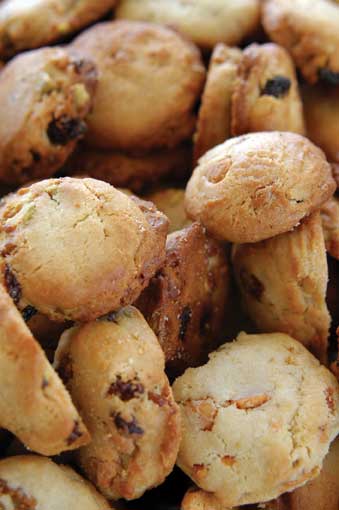|
|
|||
|
Eating Well on a Gluten-Free Diet |
|
||
|
FREE! Natural Weight Loss
Program recommended by The Share Guide
|
When most people think of “diet” they think of a short-term change in their eating pattern, but for those with celiac disease, a gluten-free diet should be continued throughout life. Celiac disease is a condition in which the lining of the small bowel (intestine) is damaged when it is exposed to gluten, the main protein found in the cereal grains wheat, oats, barley, rye, and triticale. Even small amounts of gluten cause damage to the small bowel. There are many obvious foods such as bread, cakes, cereals, and cookies that contain gluten, but there are also foods and ingredients that are less obvious such as sausages, corn flour sauces, gravies, and malt vinegar. You may ask the question “Why do people develop celiac disease?” The answer is unknown. Both genetic and environmental factors play important roles in celiac disease. Common symptoms can include anemia, bloating, chronic diarrhea, flatulence, constipation, stomach pain, vomiting, and/or weight loss. Having even small amounts of gluten in the diet may cause damage to the intestine. These small amounts may not produce symptoms immediately; however, damage to the intestine caused by any amount of gluten may lead to poor absorption of nutrients. This may result in deficiencies of nutrients such as calcium and iron. In the long term, continuing on a diet containing gluten substantially increases the risk of bowel cancer in someone with celiac disease. After gluten is removed from the diet, symptoms subside. The time for this varies between individuals. Someone with celiac disease will always be sensitive to gluten and as such they must remain on a gluten-free diet for life. There are some nutrients that may be limited on a gluten-free diet. For this reason a gluten-free diet should not be entered into lightly, and should only be commenced after confirmation of the diagnosis of celiac disease by a doctor. Calcium, iron, zinc, folic acid (also called folate), and fiber need special consideration on a gluten-free diet. Nutrient deficiencies may occur as a result of the removal of cereals containing gluten, or because of poor nutrient absorption. Osteoporosis is a common complication occurring in celiac disease. Malabsorption of calcium and poor calcium intake are often responsible and contribute to reduced bone mineral density in celiac disease. Therefore, calcium-rich foods should be included in the diet daily. Good sources of calcium include milk and dairy foods, salmon (including bones), almonds, and unhulled sesame seeds. Most of the damage that gluten causes to the gut occurs in the small intestine where iron is absorbed. As a result, iron deficiency is common in those with newly diagnosed celiac disease. Iron is essential in the diet to carry oxygen in the blood. The best sources of iron are animal foods, particularly red meat. Our bodies are able to use the iron in animal foods more readily than in vegetable or cereal foods. Having a food containing vitamin C, such as tomato, orange juice, parsley, or red and green peppers, when having iron-rich vegetable and cereal foods, will increase absorption of iron. Zinc plays a variety of roles in the body, particularly in wound healing, growth, and vision. Cereal foods are a good source of zinc. Zinc intake may be reduced by removing many cereals from the diet. It is important to replace gluten-containing cereals with gluten-free cereals, and regularly include other good sources of zinc such as oysters, meat, chicken, brown rice, beans, eggs, and dairy products. Folic acid (or folate) is needed by several enzyme systems in the body and is particularly important during pregnancy. Women who are pregnant or planning pregnancy should discuss taking a folate supplement with their doctor or dietitian. A deficiency of folate can result in anemia. It is not uncommon for someone with newly diagnosed celiac disease to be deficient in folate, due to poor absorption of this nutrient. Good sources of folate include vegetables such as asparagus, spinach, and broccoli, whole-grain bread (gluten-free), nuts, and fresh fruits, especially avocado, bananas, oranges, and cantaloupe. Fruits, vegetables, breads, and cereals (particularly the whole-grain varieties) are the best sources of fiber. High-fiber foods stay in the stomach longer, resulting in an extended feeling of fullness. High-fiber diets also produce softer, bulkier stools and are important in preventing constipation. Many of the best cereal sources of fiber, such as whole-wheat breads and cereals, must be excluded on a gluten-free diet. For adequate fiber it is important to have plenty of fruits and vegetables, legumes such as chickpeas and kidney beans, gluten-free cereals, gluten-free pasta, gluten-free bread, and grains such as rice and corn. The USDA’s recommended daily intake of fiber is 38 grams for men aged 19-50, and 25 grams for women in the same age category. A more advisable intake may be 35-45 grams (3-4 ounces) per day. Following a gluten-free diet is essential in the management of celiac disease. A dietitian is professionally qualified to provide guidance and nutritional advice to ensure that a gluten-free eating plan is manageable as well as being nutritionally balanced. Excerpted with permission from Gluten-Free Cooking ©2007 by Ruby M. Brown, published by Basic Health Publications, Inc., Laguna Beach, CA. Available in stores or visit www.basichealthpub.com. Resources Celiac.com - a website that provides a variety of resources and information for people on gluten-free diets. Gluten Free Mall (GlutenfreeMall.com) online shopping for those on gluten-free diets. Heartland’s Finest (HeartlandsFinest.com) Bean based gluten-free pastas, cereals, and flours. Mariposa Baking Co. (MariposaBaking.com) Gluten-free Brownies and Biscotti. Pamela’s Products (PamelasProducts.com) Gluten-free cookies, baking mixes, and biscotti. NEW! Natural Quit Smoking Program recommended by The Share Guide: learn more MORE
HEALTH ARTICLES Home Shop |
||
|
|
|||
|
|
|
||

